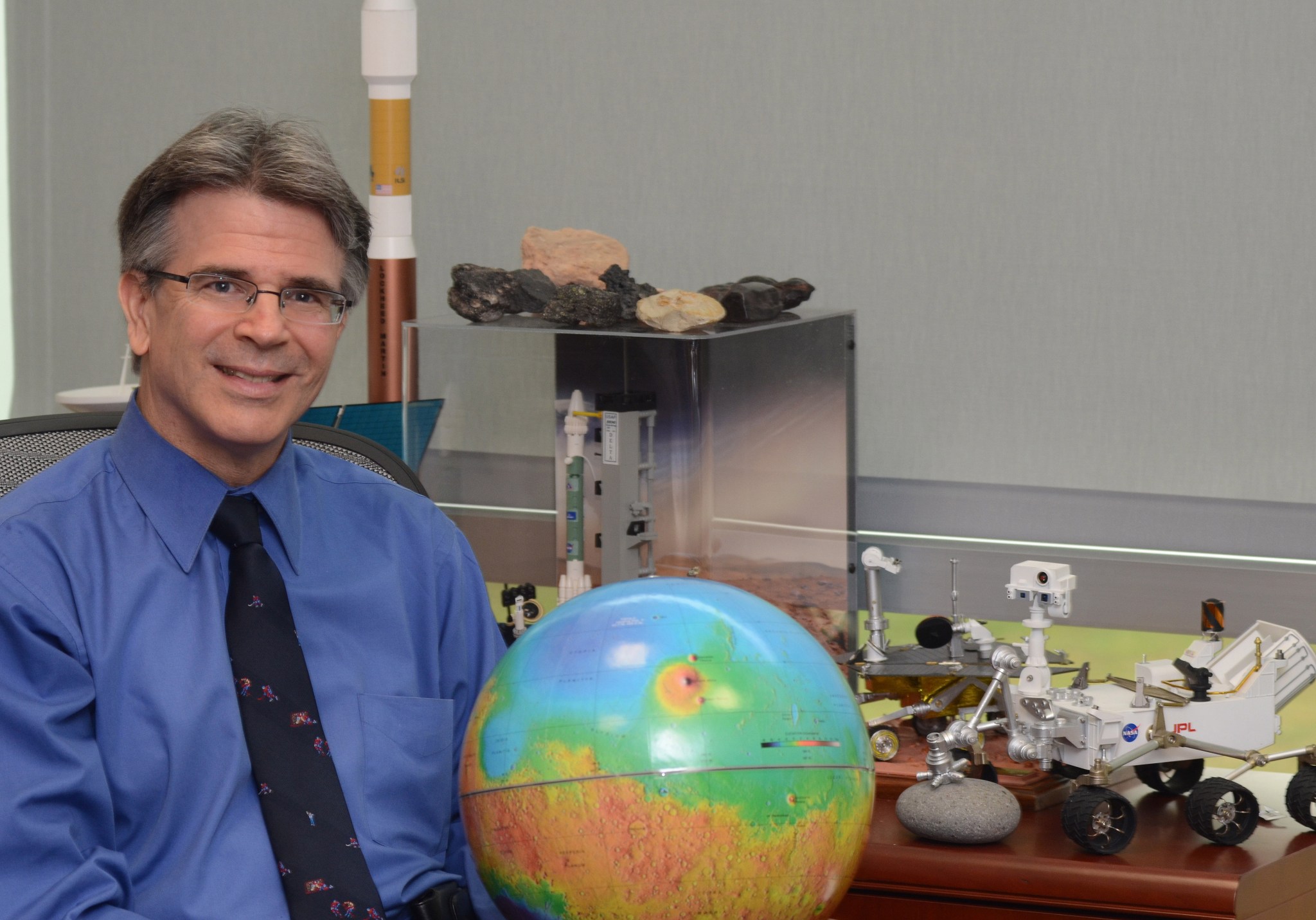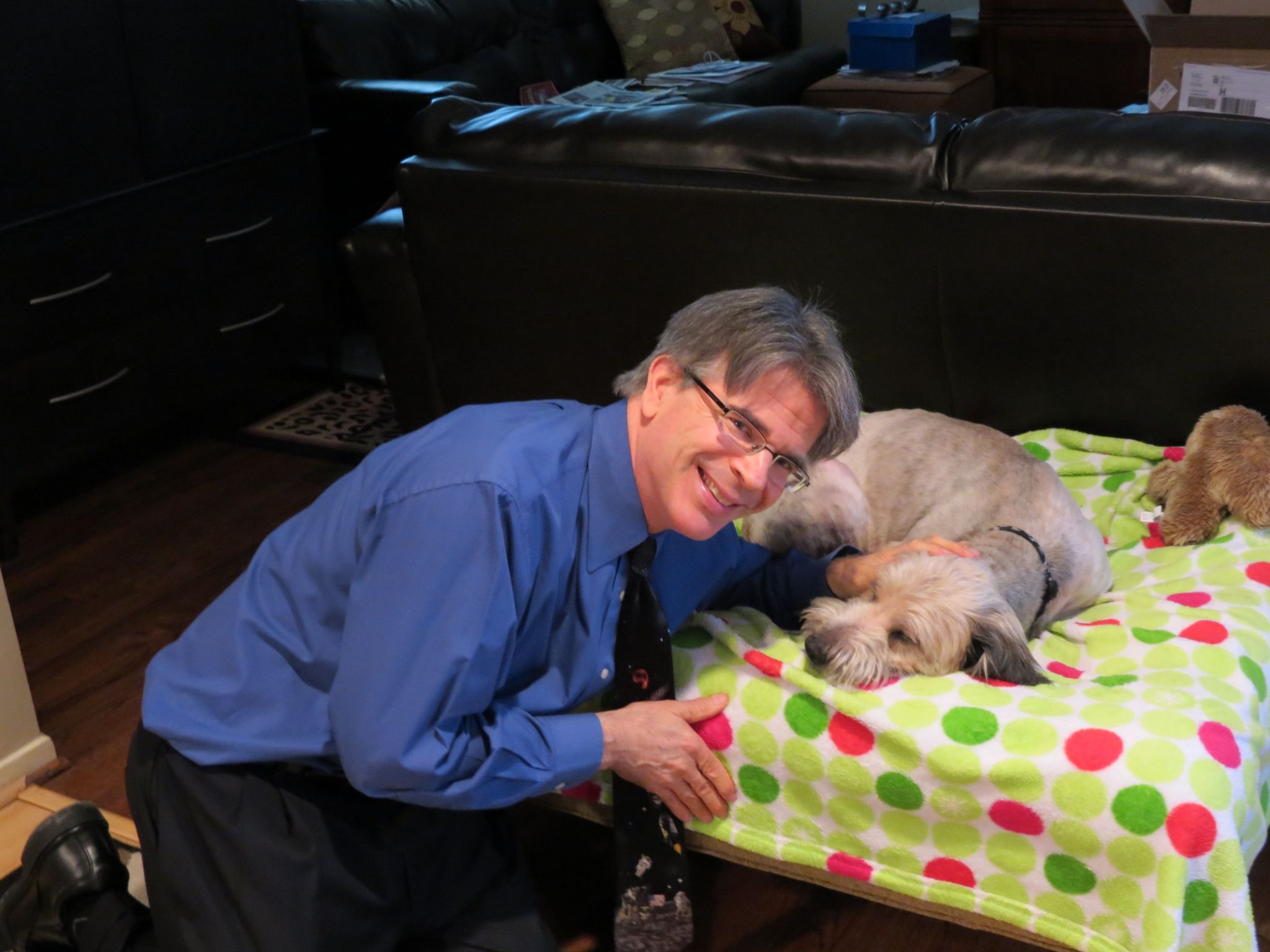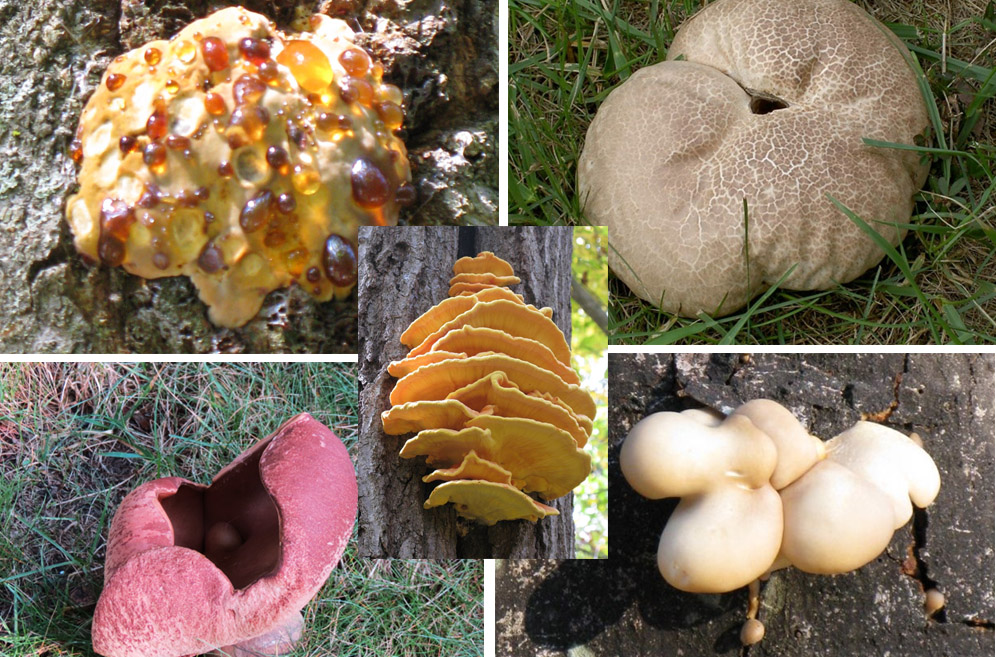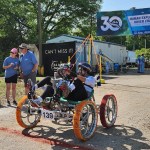Name: Jim Garvin
Title: Goddard Chief Scientist
Formal Job Classification: Senior Scientist
Organization: Code 600, Sciences and Exploration Directorate, Office of the Director
What do you do and what is most interesting about your role here at Goddard? How do you help support Goddard’s mission?
I am the professional catalyst who helps inspire the women and men of science and engineering at Goddard to pursue our next missions of discovery. I help catalyze the innovative science for the new missions that our scientists and engineers need to develop for our agency to move forward in our understanding of the universe. I look at myself as someone who channels the ideas of our people to help them implement their ideas now and especially in the future.
We have no lack of ideas here at Goddard. Indeed, we have plenty of vision.
I create the unforeseen opportunities by finding connections, especially between scientists and engineers. I help identify the ideas, connect the dots, and then help them find the professional processes for their ideas to develop and ultimately be implemented.
I believe that Goddard’s amazing strength is the art of the engineering of science. It sounds radical at first glance, but what it means is that we have the science vision to tackle any of the great Grand Challenge problems. What is the climate of an exoplanet orbiting a nearby sun? Is there life beyond Earth and how can we tell? Engineering solutions to enable our science-driven missions is our job. I believe that Goddard has a beyond-words exemplary team.
I am more akin to being the chief science adviser to our center’s senior leadership. I provide those catalytic moments to allow our engineers and scientists to do remarkably amazing things in space. I was fortunate to play the same role about 10 years ago when I was NASA’s chief scientist at Headquarters. I am beyond lucky. What makes my job particularly fulfilling is that our boss is sensational and entirely supportive of all of our science and engineering.
I’m also fortunate to have some time to continue as a practicing planetary geoscientist. I’m co-investigator on the Curiosity Mars Rover imaging team. I’m involved with the OSIRIS-REx mission as a supporting investigator for one of its lidar sensors. And I am most privileged to be the deputy principal investigator (D-PI) for the potential Deep Atmosphere Venus Investigation of Noble gases, Chemistry, and Imaging (DAVINCI), a mission to bring the U.S. back to the planet Venus and its fascinating atmosphere and mysterious mountains, led by PI Lori Glaze.
How does a professional catalyst work?
There are many different ways to catalyze and inspire people to realize their scientific engineering goals and objectives. My particular angle is to be an effective communicator and connector from our people’s ideas, such as the question about how Venus’ atmosphere works, to colleagues here and across the country, to develop a mission-level solution to address these science questions.
For example, if a certain scientist wants to understand why Europa’s oceans could be filled with life, my job is to help them identify pathways to pursue the answer even if the agency’s plans for missions to pursue such questions are not yet concrete. This could be through Goddard, Headquarters and even partnerships with other key centers such as NASA’s Jet Propulsion Laboratory in Pasadena, California.
I am an enabler in a positive fashion. I help communicate and connect the pieces so others can do the cool stuff in space and discover how our universe works.
I don’t tell people what to do, I help others realize their ideas by actually doing them. As such, I sometimes see myself as a dream maker.
Who helped you become such a brilliant communicator?
I was fortunate enough to attend Brown University as an undergraduate. The late Brown professor Tim Mutch was a particularly gifted science communicator. He helped catalyze my interest in communicating the “science message” starting when I was a freshman. He became the science leader for the Viking Lander cameras and later the associate administrator for space science at NASA Headquarters.
I returned to Brown as a graduate student and was lucky enough to have been Tim’s last student before his untimely passing. He died climbing the Himalayas in 1980. My last letter to him was returned unopened and his wonderful wife later called me to explain. He experienced exploration firsthand as a mountaineer and as a geologist. He helped me and many others learn how to communicate the magic of science.
One of Tim’s best friends was Noel Hinners, then Goddard’s center director, who hired me straight out of Brown to work as a scientist on Mars and Venus missions at Goddard. He wanted me to extend what we explore at Goddard to other places such as Mars. Noel gave me so many opportunities as an early-career scientist. Within a year of being at Goddard, I was fortunate to be speaking at NASA Headquarters to senior NASA officials and on national television.
Noel introduced me to astronaut Sally Ride after the Challenger accident in 1986. At that time, I was given the opportunity to work with her for a year, 1986 – 1987, on reestablishing NASA’s leadership in space on her special task force. I was the lone scientist on the committee and learned from my teammates about how to extend NASA to new frontiers. She was a master team builder and communicator as well as a truly inspiring person.
In 1999, NASA Administrator Dan Goldin asked me to chair the NASA Decadal Planning Team (DPT), a virtual institute designed to shape a vision for NASA’s future in exploration. Our job was to come up with a new vision for NASA beyond the International Space Station and Hubble Space Telescope. This incredible DPT team and our activities provided me with a great deal of communication opportunities with important people. Our DPT was able to catalyze new approaches across NASA for the future of human spaceflight during our time supporting Administrator Goldin.
Basically, over the course of my 30-plus year career at NASA, I have had wonderful opportunities, and I was guided by extraordinary people, including Wade Sisler of Goddard’s Office of Communications. Wade gave me many chances over the years to learn how to best communicate science messages about our missions and discoveries. Without him, I would never have learned what I have been able to do.
What was one of your most unique communication venues?
In January 2004, the night before the Opportunity Mars Rover landed, I was on David Letterman’s “Late Night” TV show. It was surreal. I was there as the “straight science guy talking about Mars” while Dave was asking poignant and often humorous questions. I was lucky the senior leadership at NASA allowed me participate as a guest on the show at such a compelling time and it was so much fun.
Matthew Broderick was also a guest on the same show and was so impressive. Dave was really cool and his supporting people were phenomenal, even for an unknown science geek like me. The show is actually taped from around 5 p.m. to 6:30 p.m. in New York City at the Ed Sullivan Theatre.
I did not even see the show until someone later gave me a tape. But I did receive a Letterman hat. And Jimmy Fallon was on my flight from JFK to LAX, so I felt as if I were amidst the gods of TV. He winked at me and I winked back while respecting his privacy at one bizarre moment on the crowded flight.
After taping, I flew directly from JFK to Los Angeles to arrive at JPL for early morning reviews concerning the landing of our Mars Opportunity Rover. The rover Opportunity landed that next evening on Mars and all was great in the solar system!
Who is your audience?
My passion is to communicate the science associated with our NASA missions the taxpayers pay us to do. It’s a privilege beyond imagination to conduct such missions of scientific discovery. I have spent my entire career doing this and mine has truly been a wonderful life.
When we go to Mars with our intrepid robotic spacecraft, we are not sending tons of money to bury in the Martian sands. We are discovering who we are, how our solar system works, and whether we are alone. I think the people of this country deserve all that we can give them for their investment in us. That’s a key part of my job. When given the opportunity, I will work in earnest to ensure this message is carried forward. I have been lucky to have had so many opportunities to experience the thrill of science via our NASA missions.
What is your personal catch phrase?
The catch phrase for the commencement speeches I occasionally give is, “Never wait to wonder.” I’m not sure who first said this, but I love it. It embodies the curiosity intrinsic to the scientific exploration that is NASA’s duty and privilege to carry out for everyone.
How have curiosity and observations fueled your creativity to enable new science?
Curiosity has inspired me every second of my waking life. My penchant for observations and innate, unbounded curiosity have fueled my entire career and life.
My first memory as a tiny child, just two years old living in Poughkeepsie, New York, was my curiosity about the rocks, trees and bugs in our backyard, much to the chagrin of my non-scientific parents who must have wondered, “What the heck?”
When I was in ninth grade, I convinced one of my teachers to allow me to completely map every tree in the forest that encircled our school before developers cut them down. I spent a month, slogging through the mud, holding maps, and counting every single tree to understand the verdant forest, and to document it in the name of science. That’s curiosity-driven research at a young age and the kind of thing I did throughout my childhood and will continue doing the rest of my life.
While in junior high school, I discovered an insect in a Connecticut swamp that had previously not been observed or catalogued in all of New England. The tiny, semi-aquatic insect is called a toad bug. It is about the size of a small ant and lives at the edge of ponds.
When Noel Hinners empowered me to find a new way to explore Mars back in 1985-1986, I told him I wanted to measure the landscapes of Mars in three dimensions in human scales, the scale at which people would walk on the surface and eventually drive rovers on in the future. My driving passion resulted in the Mars Orbiter Laser Altimeter (MOLA), a 1980s experiment that employed the first laser altimeter to map the planet Mars. My dream came true thanks to the engineers of Goddard and some of my fellow scientists. I still pinch myself that it actually happened.
I am very lucky that I can dream of science possibilities and then live to witness my dreams coming true. Curiosity fuels creativity, which enables new science, often never previously considered. This has been my thematic approach. This is my 40th year as a planetary scientist, starting an intern for the Viking Lander 2 while a student at Brown and then Stanford University.
What is your educational background?
I have an undergraduate degree in applied math and computer sciences from Brown University, with additional coursework in geological sciences. I graduated Phi Beta Kappa. I then went to Stanford University for a master’s in computer science. While there, I connected with Professor Tim Mutch at Brown and returned to Brown for a Ph.D. in planetary geology with emphasis on Mars and Venus, and was fortunate to study under professor Jim Head. From Brown, thanks to Noel Hinners, I received a staff appointment at Goddard as a scientist right out of graduate school.
How do you view your role as a team leader?
Science and engineering are all about teamwork. I think of myself as the goaltender. As a former ice hockey coach of mine once said, “On the eighth day, God gave us hockey.” I have always agreed.
In ice hockey, the goaltender is the one who ensures that the puck stops here. I see myself as the person in the background protecting the game and net for the team to enable others to win the game by scoring. My job is to make sure we do not lose the game, in this case, of scientific exploration of the universe.
This is my mindset when I am engaged in all team activities. Do the mission, protect the net, help others score the goal, and discover our place in space.
I would rather that other people, such as the scientists, engineers, managers and artists, get the credit because they do the tough work. My ambition is to see others do well and discover new things. It’s not about me, it is about them! That’s how great Goddard missions are always accomplished. Communicators channel the message from their team. This is what I love to do, when given the chance.
Working on missions and having them fly and operate in space is a joy. The fact that my missions have all flown and worked successfully is a tribute to the team members who developed their hardware to ensure that science could be accomplished. I am forever grateful to all of them.
Please tell us about your TED talk?
In April 2014, I gave a TED talk in Traverse City, Michigan, a beautiful little enclave a couple of hours from Detroit. My overarching theme was, “Space is the forever frontier.” (Visit: http://tedxtalks.ted.com/video/Space-the-forever-frontier-Jame). I wanted to engender the spirit of space exploration with catalytic curiosity to inspire creative engineering and science. It was fantastic and the crowd was wonderful. I used a presentation approach that utilized a continuous stream of all video animations. I had 14 minutes to talk about space in a way that I adore. I am forever grateful for the chance to talk about space and the science we do in my own intensely personal and passionate way at such a venue.
One dream of mine is for some group to fund a special TED event focused exclusively on space with a dozen of the most effective science communicators as presenters. In this “TED Does SPACE” event, I could foresee an agenda in which the TED talks are interwoven with space-related music and art. Indeed, I believe progressive rock music inspired many space engineers and scientists and I was one of them starting as far back as high school when I attended my first YES concert.
Who inspires you?
For the most part, teachers have inspired me throughout my life. Noel Hinners was an optimistic, encouraging enabler as a great leader of science here at Goddard and also at NASA Headquarters and at Lockheed Martin. He never said no; instead, he always asked, “How can I say yes?” I really respected him and looked up to him.
I also admired Sally Ride who was quietly focused on doing great things. She was a brilliant physicist who understood space flight, as well as the first U.S. woman in space. I will be forever grateful for the opportunity to work for her during the post-Challenger days on a team chartered to brainstorm our future in space.
Ed Weiler, a former Goddard center director and NASA associate administrator for space science, is another inspiring leader in the same category. Ed is a world-class astrophysicist who demonstrated leadership to so many of us. Ed was able to listen to people about areas that were not his field of science and to discover the pathways forward. He was passionate about the work of NASA, and he allowed me to help him lead us to Mars with missions such as the Curiosity rover.
How do you inspire others?
All scientists stand on the shoulders of those who came before them. I try to enable talented young people to go on to achieve great things in science just as others did for me.
One of my former interns is now at a major university achieving wonderful science in astrobiology. She is a rising star who will certainly lead missions in her lifetime. Just being able to help get her started has been a blast for me.
I have always been inspired by people who enabled others to achieve amazing things beyond themselves. That is what “paying it forward” is all about.
Is there something surprising about you that people do not generally know?
Now that our two children are in college, my wife and I enjoy walking our rescue dog Glenda through the woods on many evenings while I look for interesting fungi. I have always been interested in life that operates in such exotic but useful ways; thus, my curiosity about the sometimes dynamic fungi. Ever since I was a kid, I have been fascinated with fungi and have a photographic collection of some of the more interesting I have witnessed including one species that resembled a croissant.
If you could meet and talk to anybody, living or dead, who would it be and what would you ask them?
One person I would like to talk to is Leonardo da Vinci. I would like to understand how his brilliant thinking could be extended to today’s context. It would be revolutionary. His legacy inspired the name DAVINCI for our current Venus mission concept proposal for NASA’s Discovery Program.
The other person I felt impassioned to meet is the noteworthy explorer Magellan. He was the first person, in effect, to orbit the Earth, and the first great exploration mission planner. I would like to understand how his motivations allowed him to achieve this centuries before we undertook missions to space such as Apollo, Viking and soon the James Webb Space Telescope.
What is your “six-word memoir?” A six-word memoir describes something in just six words.
Passionate. Curious. Tenacious. Dedicated. Loyal. Optimistic.
By Elizabeth M. Jarrell
NASA’s Goddard Space Flight Center, Greenbelt, Md.

Conversations With Goddard is a collection of Q&A profiles highlighting the breadth and depth of NASA’s Goddard Space Flight Center’s talented and diverse workforce. The Conversations have been published twice a month on average since May 2011. Read past editions on Goddard’s “Our People” webpage.

































